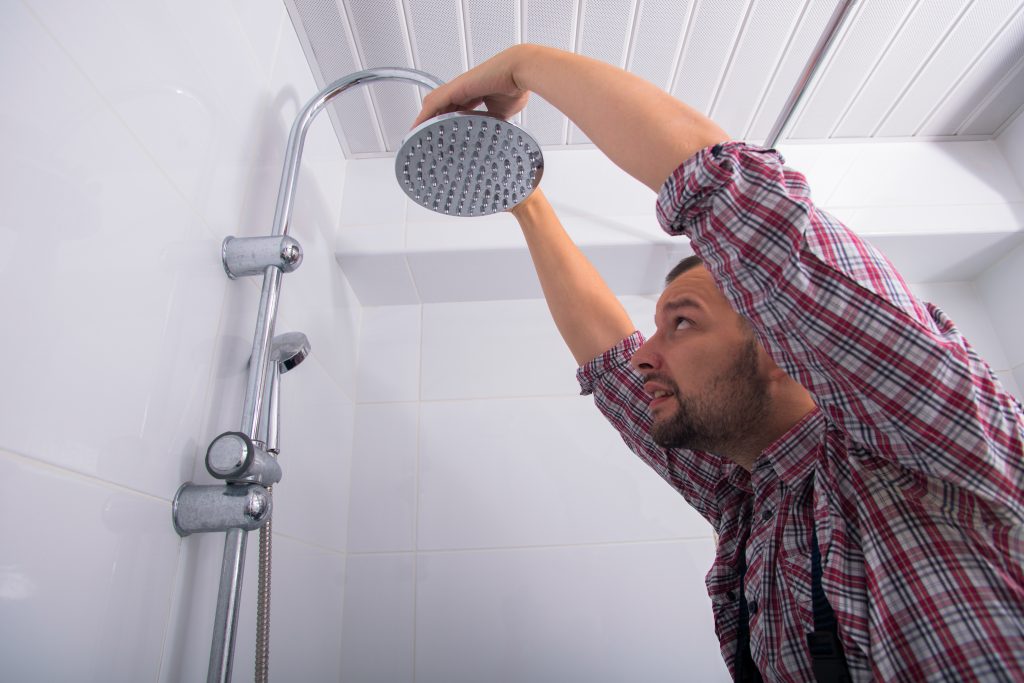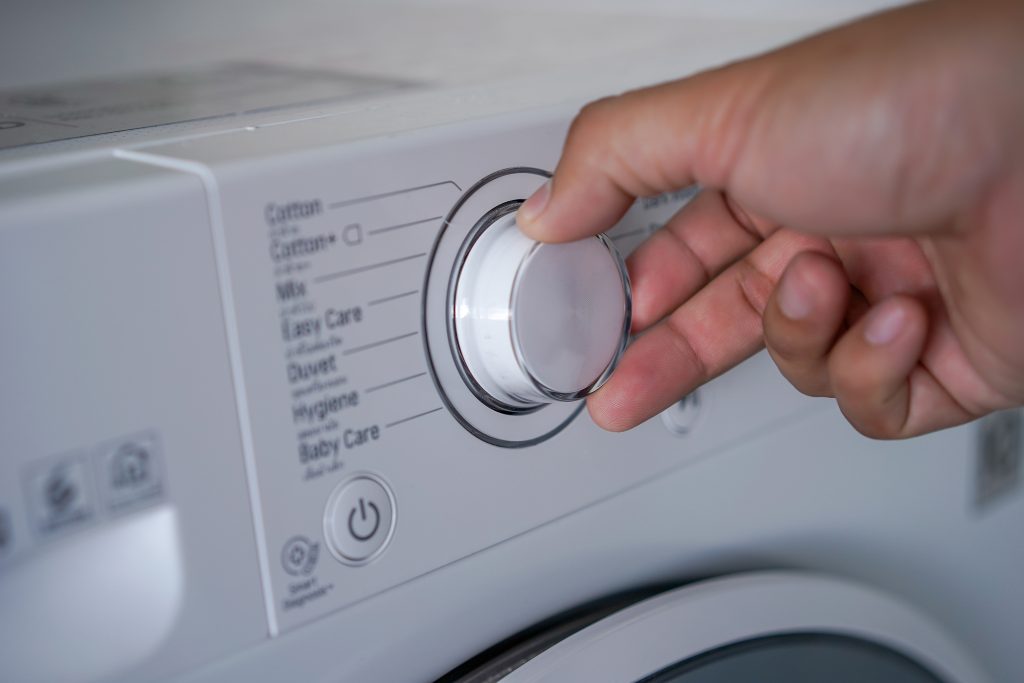Household Choices
There are many choices you can make in your home and through your daily actions to conserve water, especially in your kitchen and bathroom. Here are just a few of the biggest indoor water-savers.
Bathroom

As you can imagine, the bathroom uses a large portion of water. Between your sink, shower, and toilet, there are a lot of large and small changes you can make to conserve.
Daily Activities
Don’t leave the faucet on when brushing teeth or shaving
You can save up to 4 gallons per minute by turning off the water while brushing your teeth. That’s 200 gallons per week for a family of four. Do the same while shaving, or plug the sink while shaving and rinse your razor in the water collected. This can save up to 300 gallons of water per month.
Take shorter showers
Shortening your shower by just 1-2 minutes can save up to 150 gallons per month; this is the equivalent to simply turning off the water while lathering up your hair. Keep your shower under 5 minutes long and save up to 1,000 gallons per month. Additionally, as you wait for the water to get hot, save the cold water in a bucket and use it to water your houseplants, outdoor landscaping, or pets.
Don’t overfill the bath
While showers generally use less water than baths, if you enjoy the occasional soak in the tub, make sure you don’t overfill it when taking a bath. A full tub uses up to 70 gallons of water. You can also make a difference by plugging the tub before the water gets warm – you can counter that initial burst of cold water with hot water to still find the perfect temperature.
Flush less often
National Geographic estimates that all those flushes can add up to nearly 20 gallons per day. Employ the old adage ‘if it’s yellow let it mellow, if it’s brown flush it down’. In all seriousness, this is a great conservation strategy since the standard toilet uses roughly 3.5 gallons per flush and urine isn’t a sanitation risk. For times when it’s just your family at home, let it mellow… then of course flush freely when company is around!
Don’t use the toilet as a trash can
If you have tissue or hair or something to dispose of, use a trash can and don’t flush just to get rid of other waste.
Fixtures
Install low-flow fixtures on the sink faucet and shower
A WaterSense® showerhead can save at least 450 gallons per month. There are two different WaterSense® labels you may see. A fixture with the WaterSense® teardrop logo and the phrases “Meets EPA Criteria” and “Certified by (name of EPA-approved testing organization; these change with the type of product)” means the product you’re holding in your hands has been tested and meets water-conserving standards. A WaterSense® teardrop logo by itself may or may not meet standards. The EPA allows manufacturers that sign a commitment to water conservation and then put the logo on their products with the word “partner” underneath. This does not confirm that the product has actually been tested.
Replace your standard toilet with a low-flow or dual-flush toilet
Toilets are one of the main water users in the home and account for nearly 30 percent of an average home’s indoor water use. Standard toilets use around 3.5 gallons per flush. Low-flow toilets use no more than 1.6 gallons each time. Dual flush toilets, which have one flush option for liquid waste and a separate flush option for solid waste, use 0.8 and 1.6 gallons per flush, respectively.
Repairs/Home Maintenance
Fix a leaky faucet
National Geographic estimates that on average, 10 gallons per day of your water footprint (or 14% of your indoor use) is lost to leaks. Dripping faucets can waste as much as 2,700 gallons of water per year, which not only wastes our water, but costs you money.
Repair or replace a leaky toilet
If your toilet is constantly ‘running’, it has a leak, but some leaks can be silent. Put food coloring in the tank and if it seeps into the bowl without flushing, there’s a leak. Repairing or replacing a leaky toilet can conserve as much as 200 gallons each day – again saving water and your money over time.
Insulate your water pipes
Insulate your pipes to reduce the amount of time needed for water to get hot. And remember, as you are waiting for the water to get hot, save the cold water in a pitcher or bucket and use it to water your plants or pets.
Kitchen

Daily Activities
Defrost without water
Plan your menu ahead and thaw meat in the refrigerator instead.
Use all the water that comes out of the faucet
When running the faucet to rinse fruits and vegetables, save that water and use it to water your plants or pets.
Use one side of the sink to rinse
While doing dishes, fill one side of the sink with rinse water rather than letting the water run the entire time. This alone could save 200-500 gallons per month.
Don’t pre-rinse dishes
If you wash dishes in a dishwasher, try not pre-rinsing your dishes before you put them in the washer. Most of the time, it isn’t necessary.
Use the garbage disposal sparingly
You can conserve as much as 4 gallons of water per day. Composting is a great alternative to using the garbage disposal and using the compost as mulch around your outdoor plants can help conserve water outdoors.
Fixtures
Install a low-flow fixture on your faucet
Install an efficient dishwasher and run it only when full
An Energy Star dishwasher uses about 4 gallons of water per load while a standard dishwasher uses around 6 gallons. Washing by hand typically uses about 20 gallons. The US EPA estimates that if all United States households installed water-efficient appliances, the country would save more than 3 trillion gallons of water and more than $18 billion each year. Additionally, running your dishwasher and washing machine only when full can save up to 1,000 gallons each month.
Repairs/Home Maintenance
Fix a leaky faucet
National Geographic estimates that on average, 10 gallons per day of your water (or 14% of your indoor use) is lost to leaks. Dripping faucets can waste as much as 2,700 gallons of water per year, which not only wastes our water, but costs you money.
Other Rooms

Install an efficient washing machine and only run when full
National Geographic estimates that nearly 22% of indoor home water use comes from doing laundry. Most front-loading machines are energy- and water-efficient, using just over 20 gallons a load, while most top-loading machines, unless they are energy-efficient, use 40 gallons per load. The US EPA estimates that if all United States households installed water-efficient appliances, the country would save more than 3 trillion gallons of water and more than $18 billon each year! Additionally, running your dishwasher and washing machine only when full can save up to 1,000 gallons per month.
Consider re-routing your grey water
Hire a plumber to re-route your grey water (the water that goes down your sink, shower, and washer drains) to trees and plants (but check local codes first).